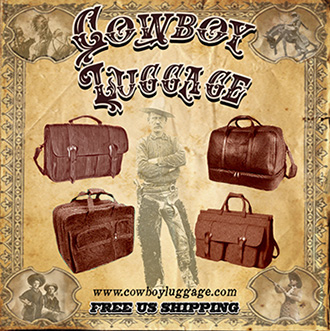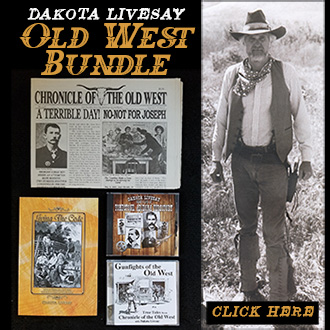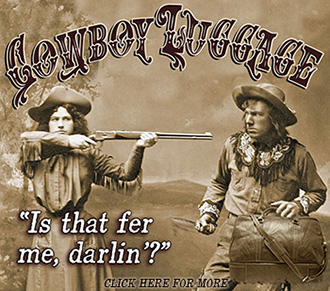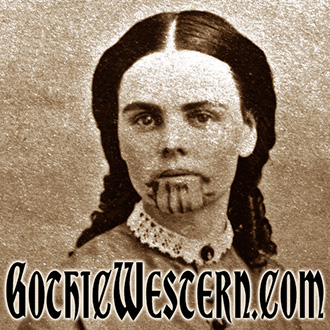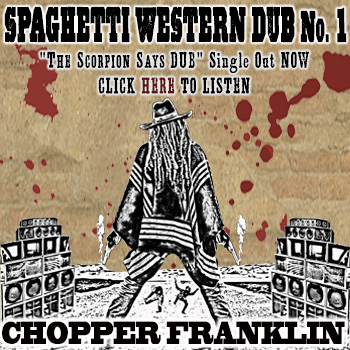
Tall Bull was a fairly common name for the Cheyenne, had by several braves. But the Tall Bull known by the whites of the
Old West was Cheyenne Dog Soldier Chief Tall Bull. And under his leadership, they became one of the toughest foes of the United States government in the bloody Plains Indian Wars.
Tall Bull and his Dog Soldiers spent the winter and spring of 1867 attacking stages and stage stations. Although, in no way defeated, they agreed to talk peace that fall. Even though the treaty they signed stated differently, they had a verbal agreement to be able to hunt the grounds above the Arkansas River as long as there were buffalo there.
The next spring Tall Bull took his warriors above the Arkansas to hunt, and while they were there, they also did some raiding. With soldiers pursuing him, Tall Bull was successful in attacking them on several occasions. So, the army put together a special force under General Eugene Carr to get Tall Bull.
On July 11, 1869, believing he had outdistanced the pursuing force, Tall Bull and his warriors made camp at Summit Springs, Colorado. But, Carr’s Pawnee scouts had found the village, and the soldiers were able to get next to the village, undetected, before attacking.
During the battle Tall Bull, and many Dog Soldiers were killed. Although the Cheyenne fought for another ten years, because of this battle, the Dog Soldiers were never again a major force.
Incidentally, even though, Carr’s civilian guide, Buffalo Bill Cody, claimed to have killed Tall Bull, others in the battle say there was no way to tell who killed him, because everyone was shooting at him.
August 14, 2018 | Categories: Old West History | Comments Off on Cheyenne Dog Soldier Chief Tall Bull
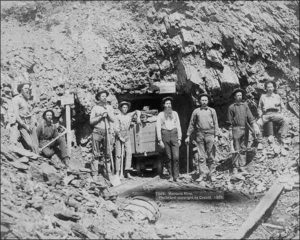
Martin Sweeny, Indian Agent, was born in Massachusetts in 1845, and decided to head out
West at the age of 23. He ended up in Arizona shoeing horses on the Apache reservation. Here he learned the Apache language, and developed an appreciation for their lifestyle.
During this time as well as Apache who were on the war path, there were those who helped the military. Because Sweeny knew the Apache language, he was hired to teach the peaceful Apache military tactics, to help them fight in conjunction with the cavalry. Sweeny worked so well with the Apache that when the local Indian agent resigned, Sweeny was offered the job.
But Sweeny was looking at other opportunities. For the last couple of years he had been investing in silver mines around the Tombstone, Arizona area. One of them, the Grand Central, was beginning to do quite well. So Sweeny left the Apache Reservation for Tombstone.
On June 24, 1878 Sweeny was visiting the Grand Central mine with one of his partners, an Oliver Boyer. A disagreement arose between the two men. Voices were raised, and a shove or two took place. Now, Sweeny was a large man, and was noted for his skill as a fighter, but he didn’t carry a gun. However, his partner did. And Boyer pulled his pistol, and killed Sweeny. Boyer was arrested and sentenced to 25 years in prison.
Although there were those shootouts that give the Old West the excitement we like to hear about, the vast majority of people who were killed by a gun, like they are today, were defenseless.
August 11, 2018 | Categories: Old West History | Comments Off on Martin Sweeny Indian Agent

During the
Old West men changed names so freely that sometimes there’s confusion as to their real ones, and their aliases. Some say the subject of today’s story’s real name was Billy Wilson; others David Anderson. In reality, what a man calls himself isn’t important; it’s what he does while using that name. Under the name of Billy Wilson, our man came to Lincoln County, New Mexico and bought a livery stable. Later he sold it, and was paid in crisp new $100 bills. Unknown to him, they were counterfeit. On the run for passing counterfeit money, he joined Billy the Kid and his renegade posse.
In 1881 Pat Garrett arrested our man. Wilson was sentenced to 25 years for counterfeiting. But, he escaped jail, and went to Texas. There he used another name… David Anderson.
Our man, using his new identity, bought a ranch. This time he used real money, got married, had children and became a respected citizen of the area. But, eventually his real identity was discovered, and it seemed he would be returned to New Mexico to serve his sentence.
But a strange thing happened. The governor of New Mexico filed a petition to have our man given a Presidential pardon. Accompanying the petition were about 25 letters, including one from Pat Garrett, the man who originally arrested him. Our man was granted his pardon.
David Anderson eventually became the county sheriff. But on June 14, 1918, unarmed, David confronted a young man who was causing a disturbance. The kid pulled a pistol, and killed Sheriff Anderson. Unlike Anderson, the young man was given no chance to reform his life. Within an hour of Anderson’s death, he was hanged.
August 8, 2018 | Categories: Old West History | Comments Off on Billy Wilson and Pat Garrett
Robert Leatherwood was not a big man. He stood only 5’ 5” tall, and weighed about 130 pounds. He was born in North Carolina in 1844. Robert served on the Confederate side during the Civil War, and eventually migrated to
Tucson, Arizona where he became a lawman. Because of his size and fearlessness, Leatherwood was given the nickname the “Little Giant.”
His greatest contribution was that of serving the public, both as a lawman and as a politician. He served a couple of terms as county sheriff, on the Tucson city council, as Tucson’s mayor and three terms in the territorial legislature. One of his greatest accomplishments was bringing the railroad to Tucson.
Leatherwood was a blustery man who was almost illiterate. The story is told of him betting a fellow poker player $20 that he didn’t know the Lord’s Prayer. The other man took him up on the bet, and started “Now I lay me down to sleep. I pray the Lord my soul to keep.” Leatherwood interrupted him, and said “OK. OK. You win,” and threw him a twenty dollar gold piece.
The heroic deed that started Robert Leatherwood off on his political career took place on May 22, 1886. He and two other lawmen were chasing Geronimo and 14 Apache, who had a white captive. On this date the three lawmen accidentally stumbled into the camp of the Apache. Leatherwood’s two companions pulled back on their horse’s reins and turned to run. But Leatherwood charged into the Apache camp, sending Geronimo and the others running for the hills. For weeks Leatherwood was hailed a hero. Then, finally he confessed that he had also tried to turn his horse… but the gunfire spooked the horse and it ran out of control through the Apache’s camp.
August 2, 2018 | Categories: Old West History | Comments Off on Robert Leatherwood – Accidental Hero
Edward T. Beard was born in Illinois in 1828. As a young man he got married, and had several children. Feeling a married life in the mid-westwas boring and confining, Edward abandoned his wife and children to head out west and become a terror to everyone he met. Edward had red hair and beard, so people naturally to call him Red Beard.
In 1873, Red Beard decided to settle down and open a dance hall in Delano, Kansas, just outside Wichita. The dance hall provided spirited drinks and spirited women for members of the 6th Cavalry stationed nearby. On the evening of June 3 a drunken soldier got into an argument with a soiled dove named Emma Stanley. The upset soldier pulled his pistol and shot Emma in the leg.
Red Beard immediately jumped over the bar, and pulled his pistol, shooting wildly. One soldier was shot in the neck and the other in the leg. Unfortunately, neither was the culprit who shot Emma. He had bugged out the back door, and was never seen again.
The shooting incident didn’t set well with the soldiers. And two nights later thirty soldiers showed up at Red Beard’s dance hall, and proceeded to shoot up the place. In the process three people were shot, including poor old Emma Stanley, who was shot in the other leg.
The soldiers then set fire to the dance hall, and watching from the street, cheered as it burned to the ground.
After this, Red Beard decided to give up the life of a legitimate businessman, and went back to being an outlaw, only to be shot and killed five months later.
July 30, 2018 | Categories: Old West History | Comments Off on Red Beard the Terror
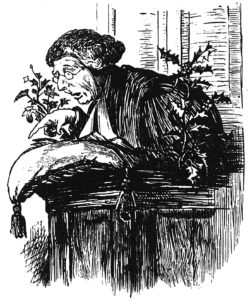 Preacher Robber Escapes Conviction of Bank Robbery on the Insanity Plea.
Preacher Robber Escapes Conviction of Bank Robbery on the Insanity Plea.
April 19, 1895, Deming Headlight, Deming, NM – Portland, Oregon, April 18. – Rev. J. C. Reed, the Baptist minister who is on trail for attempting to rob the First National bank of East Portland last February, was found not guilty by the jury on the ground that he is insane.
Judge Stevens remanded the prisoner to the custody of the sheriff and he will have an examination for commitment to the asylum.
Reed, armed with a pistol, had entered the bank at noon, held up the cashier, bound and gagged him and locked him in the vault. He was captured while he was emptying bags of gold.
July 22, 2018 | Categories: Old West History | Comments Off on A Preacher Robber
Celebrating the independence of our country was important even in the Old West. And, as we shall see, people putting on the Fourth of July in the Old West ran into the same problems as today.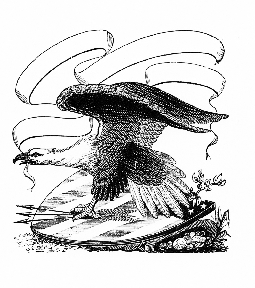
In 1868 the Nevada mining camps of Hamilton and Treasure Hill comprised of a few hardy miners and even fewer women. However, it was decided that they would have a 4th of July celebration.
They formed the flag committee, the music committee and the dance committee. The music committee’s job was simple, yet complicated. Therewas only one man in town who had a musical instrument, a violin. The complication was that he tended to get drunk. So, they had to regulate the flow of whiskey to the musician.
The dance committee comprised of all the women in town…a total of two. Like volunteer committees sometimes do, the flag committee waited until the last minute to get a flag. And then it was to late to travel the 120 miles to the nearest store. So, good ol’ American ingenuity took place. They found a quilt with a red lining, and some white canvas material. A traveling family camped nearby had a blue veil. This was doubly good because the family included a mother and four girls…more women for the dance. But the girls didn’t have shoes, making it impossible to dance on the rough planked floor. So, a collection of brogan shoes was taken up among the miners.
On the 4th of July, a parade formed at Hamilton and with the makeshift American flag proceeded to Treasure Hill. Speeches were made. Sentiment ran high. They decided to form a new town called the White Pine Pioneers, and that the flag should go into the town’s archives. Unfortunately, the town disappeared and the flag ended up being used as a bed sheet.
July 4, 2018 | Categories: Old West History | Comments Off on Fourth of July in the Old West

Jon Torsteinson was born in Norway in 1827. At the age of ten he and his family came to the United States. Americanizing his name, he became John Thompson, and at the age of 29 moved to California, and became a rancher near Sacramento. He would probably have lived and died in obscurity had he not read an employment ad in the local newspaper. The advertisement was for a mail carrier to traverse the route between Hangtown, later to be known as
Placerville, California and
Carson City, Nevada… during the winter. So John entered into the history of Old West mail delivery.
The route was 90 miles one way. But the main obstacle was the
Sierra Mountains where it didn’t snow in inches, but feet. John made a pair of skies 10 feet long and 4 ½ inches wide. For balance, he carried a 12’ pole. The mail was carried in a backpack that weighed, depending on the amount of mail, from 60 to 100 pounds. It took three days to make the trip one way.

Even though he was traveling through blizzards and snowdrifts in subzero temperatures, because of weight and time considerations, John didn’t wear a jacket and didn’t pack a blanket. He didn’t even take a weapon, and took food that didn’t require cooking.
It didn’t take long for him to pick up the nickname “Snowshoe” Thompson. Snowshoe did more than just carry the mail. He rescued people, and made emergency trips for medications. For recreation Snowshoe would ski-jump. Supposedly he could fly through the air over 185 feet.
For twenty years of Old West mail delivery, Snowshoe faced the worst nature could throw at him and was victorious. But, on May 15, 1876, after four days of illness, this 49 year old man of steel died quietly in bed.
June 21, 2018 | Categories: Old West History | Leave A Comment »

Zebulon Pike was a successful explorer. But, it seems he was successful in spite of miscalculations. He started his exploration at the age of 26 when, as a soldier, he led 20 men on an expedition up the
Mississippi River. They left in August, expecting to get back before the winter freeze. Unfortunately, he miscalculated and the waterways froze, so the small band had to spend the winter in Minnesota.
Less than three months later Pike was ordered on another venture. This time he and his men were sent to explore the headwaters of the Arkansas River. When they arrived in Colorado, Pike saw a towering peak. He decided to climb it. It was another miscalculation. He grossly underestimated the height of the mountain. Dressed only in thin cotton clothes, they struggled in deep snow and freezing temperatures, without making it to the top. Incidentally, although this mountain came to be known as Pike’s Peak, it was not something that Pike himself promoted.
During this second expedition Pike miscalculated his location, and wandered into Spanish territory, where they were captured. He and his men were moved from
Santa Fe, to Chihuahua, before being released. The whole time Pike was gathering information on the Spanish territory to be later given to his commanders.
The army was impressed with his daring, and they promoted him to brigadier general. Unfortunately, on April 27, 1813 Zebulon Pike made another miscalculation by standing too close to an abandoned British powder magazine that was exploded. A rock from the explosion hit him in the back and killed him.
Zebulon Pike was only 34 years of age. Another great man from American history who packed a lifetime in a few short years.
June 12, 2018 | Categories: Old West History | Leave A Comment »
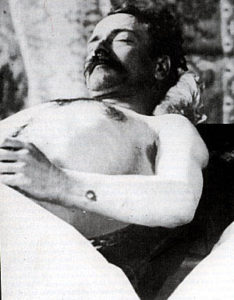
George Newcomb was born in Kansas in 1867. At a young age he went to Texas to become a cowboy. From there he drifted up to Oklahoma. He so frequently sang, “I’m a wild wolf from Bitter Creek, and it’s my night to howl,” that his friends started calling him Bitter Creek George Newcomb.
Bitter Creek joined the Dalton gang, but fortunately for him, he missed out on the Coffeeville Raid where the Daltons were wiped out. From there he drifted over to the
Doolin gang.
While at a country dance he met a 15 year old Rosa Dunn, and was smitten. Rosa became the legendary “Rose of Cimarron.”
On May 1, 1895, Bitter Creek and fellow outlaw Charley Pierce were on the run. They decided to go to the ranch owned by Rosa Dunn’s family on the
Cimarron River in Oklahoma. Bitter Creek not only wanted to see Rosa, he was also hoping to collect the $900 owed him by Bee and John Dunn, Rosa’s brothers. Unfortunately for Bitter Creek and Charley Pierce, there was a $5,000 reward on their heads.
When the two men dismounted at the Dunn’s house, gunfire opened up. With Bitter Creek and Pierce on the ground, the Dunn brothers stepped outside. Pierce let out a moan. It was silenced with another blast.
The Dunns put Bitter Creek and Pierce in the back of their wagon, and headed for Guthrie. On the way in Bitter Creek, who wasn’t quite dead, asked for some water. He was given lead instead.
We’re not sure about Rosa’s attitude concerning the event, there have been varying accounts over the years. But, with the $5,000 reward, and the $900 the Dunn brothers no longer had to pay Bitter Creek George Newcomb, I’m sure they felt pretty good about what happened.
June 9, 2018 | Categories: Old West History | Leave A Comment »
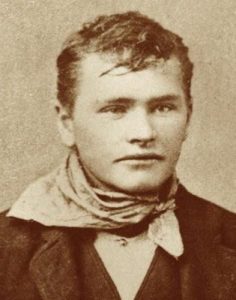
The family of Willard Christianson moved to Utah after they had converted to Mormonism. At the age of 14 Willard got in a fight, and thinking he had killed his adversary, ran away from home. As a young boy Willard fell in with bad company and started rustling cattle. While operating out of Utah’s Robbers Roost area he got the nickname of the
Mormon Kid.
The Mormon Kid met a Rose Morgan, fell in love and got married. Wanting to develop some semblance of a normal life, he and his partner in crime, Tom McCarty started a cattle ranch. But this didn’t last long. In 1892 the two of them went up to Washington and robbed a bank in which two citizens were wounded. Shortly afterward they were arrested and put in jail. But two days before their trial they attempted a jailbreak by wrapping themselves in blankets and blackening their faces to look like Indians. But it didn’t work. Actually, the attempted jailbreak wasn’t necessary because they were found not guilty.
In 1896 Willard was involved in a shootout that, in reality, could have been considered self-defense. But this time he was convicted of manslaughter and sentenced to five years in prison. After his release in 1900, Willard settled down in Carbon County, Utah where he used his earlier training to good effect by being elected justice of the peace and serving as deputy sheriff. He later moved to Price, Utah where he served as a policeman, that is, when he wasn’t busy at his other job… selling white lightning as a bootlegger.
Willard Christianson was able to live a full life dying peacefully on December 21, 1938 at the ripe old age of 74.
May 11, 2018 | Categories: Old West History | Leave A Comment »
Rufus Somerby was a military man for most of his life. But, you’re going to have to pay close attention as I go through his service record, because Rufus was ever on the move. In 1862 he enlisted in the 9th Kentucky Infantry. Within three months he was promoted to captain. After a little over a year in the infantry, he decided walking wasn’t for him. So Rufus resigned, and enlisted in the cavalry where he quickly rose to sergeant major, and two years later while fighting Indians in Arizona he became a lieutenant.
In 1870 Rufus obtained a leave, and went to Boston where he spent a couple of months trying to consume all the whiskey in the town. Finding this impossible, Rufus decided to enlist in the artillery. The fact that he was still an officer in the 8th Cavalry didn’t seem to bother him. However, it did bother the military. Rufus was given the choice of either resigning his commission in the cavalry or be court martialed. He resigned. But he stayed in the artillery.
In less than four years he was a sergeant in the 5th Artillery. Yearning to be back on a horse, Rufus either resigned from the artillery, was transferred or just did another double enlistment. But he ended up back in the cavalry where he became a sergeant.
It was the Christmas season of 1882. Rufus, ever on the move, had applied for the position of commissary sergeant, but he was flatly turned down. Feeling he had nowhere else to go, on December 26, while in the barracks with his men, Rufus Somerby ended his military career by shooting himself with his carbine.
May 2, 2018 | Categories: Old West History | Leave A Comment »

In 1869 the
Kiowa and the
Comanche were being relocated to a reservation near Fort Sill, Oklahoma. President Grant felt if Quakers were hired as Indian Agents, they would be able to teach the Indians to be pacifists. So, Lawrie Tatum, a man known for his Quaker work, was appointed to the unenviable job as the Kiowa-Comanche agent.
Although the 47 year old knew little or nothing about wild Indians, he felt that he could tame them with honesty, industry, patience and kindness. The Comanche weren’t a major problem. But the Kiowa were impossible.
Showing his trust, Lawrie had the military withdrawn from guarding the provisions. The Kiowa saw this as weakness, and not only stole the provisions, but they started making raids to nearby
Texas.
Learning this approach wasn’t going to work, Lawrie tempered it with toughness. He had the three chiefs responsible for the Texas raids arrested. He put the provisions under guard, and refused to give any provisions to marauding Indians.
It had become normal for the government to ransom any white captives taken on raids. But continuing his hard line, Lawrie, feeling ransom only encouraged the taking of captives, refused to pay any.
Increasingly Lawrie felt that force was necessary to control the Kiowa. Eventually his actions conflicted with his Quaker superiors. And losing confidence in Grant’s Peace Policy, in 1873 Lawrie resigned.
Lawrie Tatum continued his Quaker belief, writing several books in support of it. He also wrote a classic about his experience with the Kiowa and Grant’s policy. On January 22, 1900, at the age of 78, he died.
Incidentally, late in life Lawrie was appointed the guardian of an infant by the name of Herbert Hoover, the man who became our country’s 31st President.
April 24, 2018 | Categories: Old West History | Leave A Comment »

With the completion of the
transcontinental railroad by the Central Pacific and
Union Pacific Railroads in 1869, the men dubbed as the “western railroad barons” decided to join forces and create a monopoly on any rail traffic coming to the
West Coast. So, in 1870
Collis P. Huntington, Charles Crocker, Leland Stanford and Mark Hopkins created the Southern Pacific Railroad.
These men had very strong, commanding personalities. But, Collis P. Huntington was much stronger and determined that the others. Starting with nothing, Huntington had gone to the California gold fields in 1849, where he shoveled gravel for just one morning… which he considered the most foolishly squandered time of his life. The next day he started selling hardware, and never looked back.
By 1877, the Southern Pacific Railroad controlled 85 percent of California’s rails. From there Huntington and the Southern Pacific looked at creating a transcontinental railroad through the southern part of the United States. With the Texas and Pacific Railroad already on the project, Huntington had to work fast. Marshaling all of his resources, in 1881 the Southern Pacific and Santa Fe Railroads united at Deming, New Mexico, creating the second transcontinental railroad. It took two more years, and on February 5, 1883, by gaining control of a number of smaller railroads, the Southern Pacific now had what they called the “Sunset Route” from New Orleans to California.
Now with a virtual monopoly over rail service to California, Huntington and his business partners started charging exorbitant shipping rates. With its tentacles creating a stranglehold on much of California’s economy, the Southern Pacific got the nickname of “the Octopus.” This resulted in California became the first state to start regulating the railroads.
April 8, 2018 | Categories: Old West History | Leave A Comment »

Wherever Mickey Free went, death seemed to follow. Even when he was a kid.
On January 27, 1861, at the age of 12,
Apache Indians kidnapped Mickey. An inept soldier by the name of Lt. Bascom led a command to find him. Lt. Bascom came across Cochise and some of his braves. And although Cochise knew nothing about the kidnapping, Lt. Bascom accused Cochise of stealing Mickey. A fight ensued, and some Indians were shot. Cochise went on the warpath, and
in 60 days, he and his braves killed 150 whites.
Later Mickey gained his freedom. Although Mickey’s real name was Felix Martinez, when he returned he started using the name Mickey Free. Some say Mickey came from his Irish father. His last name “Free” came from his being free from captivity.
Mickey has been described as having long, unkempt, fiery red hair and a red mustache. He only had one eye. He supposedly had a mug that looked like the map of Ireland. A nice way of saying that he was really ugly.
Mickey was a scout for the Army in the Apache campaign. The Apaches didn’t like him, and the feeling was mutual. He would spread rumors about the Apache, and when the Army used him as an interpreter, his translating was to the detriment of the Indians.
One time Mickey was sent to capture an Apache. He tracked him for 300 miles. After Mickey killed the Apache, realizing the body was too heavy to carry, he carved off the Indian’s face as proof of the kill.
Mickey only had one friend, chief of scouts,
Al Sieber. Even he said of Mickey, “He’s half Mexican, half Irish and whole SOB.”
April 5, 2018 | Categories: Old West History | Leave A Comment »
 February 10, 1887, Daily Star, Tucson, Arizona Territory – The steady progress of Tucson in the direction of “culchah” and civilization, awakens the liveliest hopes of the future. As evidence that we are on the right road at last, we append the following rules of deportment posted in the office of a popular old resident of this country:
February 10, 1887, Daily Star, Tucson, Arizona Territory – The steady progress of Tucson in the direction of “culchah” and civilization, awakens the liveliest hopes of the future. As evidence that we are on the right road at last, we append the following rules of deportment posted in the office of a popular old resident of this country:
1 – Gentlemen entering this office will leave the door wide open, keep their hats on, and walk with the right hand carelessly foundling the handle of their six-shooters.
2 – Those having no business should remain as long as possible, take a chair and lean against the wall, and may prevent its falling on us.
3 – Gentlemen are required to smoke, especially during office hours; tobacco will be supplied.
4 – Spit on the floor, as the spittoons are only for ornament.
5 – Talk loud or whistle, especially when we are engaged. If this does not have the desired, effect, sing! And if that will not answer, then dance, or tell some old story; long ones preferred.
6 – Put your feet on the tables, or lean against the desk; it will be of great assistance to those writing on them.
7 – As an office is exclusively for your accommodation, call frequently when you have leisure – especially when we are busy; then ‘tis very pleasant.
8 – In making your visits, never come alone – the old adage – “the more the merrier.” Ride your broncos right into the office. It will make a good laugh all round. So Long.
March 22, 2018 | Categories: Old West History | Leave A Comment »
“I can tell by your outfit that you are a cowboy.”
 Next to his hat, a cowboy’s footwear has traditionally been the most important symbol of his identity. Here are some little known facts about Old West Cowboy Boots:
Next to his hat, a cowboy’s footwear has traditionally been the most important symbol of his identity. Here are some little known facts about Old West Cowboy Boots:
Prior to the end of the Civil War, cowboys wore heavy-soled boots of virtually any style they could find. Often his boots were made on the same form for both the right and left foot. Although they eventually conformed to the foot, this wasn’t the most comfortable way to make a boot.
With the beginning of the cattle drives, and the cowboy having to work cattle and ride a horse for months at a time, he started realizing he wasn’t wearing the best boot for the job. So, when he got to Abilene and the other cattle towns, the cowboy got together with boot makers and came up with what has come to be known as the cowboy boot.
Early boots were called “stovepipes” because they were black, about fourteen inches tall and had level tops. The 1870’s cowboy had three choices: boots off the shelf, boots made by a local boot maker or custom made mail order boots.
The Old West cowboy was very vain about his attire. He was willing to pay as much as a month’s wages for a pair of custom boots that were designed more for looks than comfort.
Although the northern cowboy and the southern cowboy dressed differently, they did agree on their boots. The exception was how the boot was decorated. The Texas cowboy wanted a lone star or crescent on the front of his. The northern cowboy’s boots were heavily stitched. And their tops were rarely less than seventeen inches high.
Boots had square or rounded toes. (Pointed toes are a modern design.) The soles were thin. Supposedly, to better feel the stirrup. Besides, a cowboy never walked very far. The heels were “underslung.” A small foot was desired, and the underslung heel provided a size ten foot with a size seven footprint.
The heels were 2 ½ inch to as much as 4 ½ inch high. This prevented the boot from hanging up in the stirrup. In addition, the heels made it possible to “dig in” when working cattle. The tall heel also added a couple of inches to the height of a cowboy, who tended to be on the shorter side.
In the 1890’s, following the cattle drive era, performers in Wild West shows started wearing highly decorated boots. Then came the movie cowboy. Boots were no longer designed for protection against the elements and critters, or for riding and handling cattle, but for show and tell. And to tell it best, they always added a pair of jingling spurs! You can read more about cowboy boots in the Old West by grabbing this great book HERE.
March 18, 2018 | Categories: Old West History | Leave A Comment »
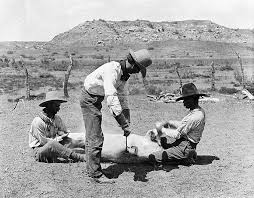 In the late 1860’s and the 1870’s a cattle rancher’s life was simple. He lived in a small cabin, and worked along side the cowboys on his ranch. A cowboy respected his boss, and he would give his life for the rancher and his cattle. As they phrased it, “They rode for the brand.” No one would have thought that cowboys go on strike.
In the late 1860’s and the 1870’s a cattle rancher’s life was simple. He lived in a small cabin, and worked along side the cowboys on his ranch. A cowboy respected his boss, and he would give his life for the rancher and his cattle. As they phrased it, “They rode for the brand.” No one would have thought that cowboys go on strike.
By the 1880’s things were changing. Ranch owners were now living in large homes or were absentee landlords…They were often Eastern, British or Scottish investors. They had ranch foremen to work with the cowboys. When these “foreign” owners did come out west, they brought with them customs unfamiliar to the cowboys. The gap between the cowboy and the owner became wider and wider.
During the spring of 1883, the cowboys from three ranches in the Texas panhandle were rounding up strays together. And, one evening while setting around a campfire, the cowboys were doing their usual griping about working conditions, when they decided to do something about it…to go on strike.
Their demands were simple. Among them, a cowboy’s income would increase from $30 to $50 per month. A cook would get $50 per month. And the head of an outfit would get $75 per month.
Unfortunately, for the cowboys, they quickly drank and gambled away their strike fund, and the area was full of drifters looking for a job. So the strike didn’t last more than a couple of weeks. Some of the cowboys went back to work. Others left the area.
This strike ended up being just one more nail in the coffin of the Old West cowboy as ranchers set up rules to confine even more their traditional activities.
February 3, 2018 | Categories: Old West History | Leave A Comment »
Bat Masterson and the County Seat War: In October of 1887 a vote was held in
Gray County, Kansas to determine the county seat. The winner was Cimarron. But some of the key citizens of Ingalls weren’t happy with the outcome. And they took their case to the courts. For over a year the courts did nothing.
Finally Asa Soule, from Ingalls, decided to take the situation into his own hands. He figured that as the crown or miter was the authority of a king, the records of a county were the authority of a county seat. So, on January 11, 1889 he deputized a group of men with the objective of stealing the county records. These lawmen weren’t novices. They included Bill Tilghman, Neal Brown and two of the Bat Masterson brothers, Jim and Tom.
Early Sunday morning the group rode quietly into Cimarron. Neal Brown and the two Mastersons started carrying out the records as the others stood guard. Unfortunately for them, an alarm was sounded, and guns started firing. The three record carriers were caught inside the courthouse. The rest got away with the records. More than two hundred armed men started shooting at the courthouse. In the process, one citizen was killed.
For more than 24 hours the men were trapped inside. Then mysteriously a truce was called and the three men were allowed to leave town unscathed. What happened? Well, Bat Masterson heard about his brothers’ plight, and he telegraphed Cimarron stating, that if either of his brothers were hurt he would “hire a train and come in with enough men to blow Cimarron off the face of Kansas.”
Oh yes, four years later another election was held and Cimarron again won.
January 16, 2018 | Categories: Old West History | Leave A Comment »

During the 1860’s and 70’s Dull Knife was one of the leading chiefs of the Northern Cheyenne. Early on, he realized the need to be at peace with the United States. But, what he saw happening worried him. For instance, in 1864, a group of Colorado militiamen attacked and killed a peaceful Cheyenne village at Sand Creek.
Although Dull Knife didn’t personally participate in the Little Big Horn, some of his warriors did. This resulted in their village being attacked the following winter while camping along the Powder River in Wyoming. Because of the loss of lives and supplies, he surrendered in the spring.
In 1877, Dull Knife and his people were relocated from their homeland in Wyoming to the area that is now Kansas and Oklahoma. Not able to hunt on their traditional lands, and unable to live on government rations, a year later Dull Knife and his tribe started on a march back to Wyoming. Although Dull Knife had told everyone that his return was a peaceful one, the army looked upon them as renegades, and attacked them at every opportunity.
Again, they were captured and held at Fort Robinson in Nebraska. But, Dull Knife was determined, and he and about a hundred of his village escaped from Fort Robinson, and headed to Wyoming.
On January 22, 1879, Dull Knife had his last confrontation with the army. Although Dull Knife escaped, his remaining followers accepted their fate and returned to Fort Robinson. Dull Knife found refuge at the Sioux reservation with Red Cloud.
Four years later the government allowed the Northern Cheyenne to return to their traditional homeland. But Dull Knife was not with them. He had died a few months earlier.
January 10, 2018 | Categories: Old West History | Leave A Comment »

Alexander Todd got gold fever. But when he got to California he realized he didn’t have the physical stamina to work the gold fields.
However, it didn’t take Alexander long to see a need and fill it. The gold miners yearned for word from home. But the nearest post office was in San Francisco. It was a two-week trip there and back, and the miners couldn’t leave their claim that long.
So, on July 14, 1849 Alexander Todd started charging $2.50 to take a letter to the San Francisco post office. There was a $1.00 fee just to inquire if a miner had a letter at the post office, and $16.00 for each letter he brought back.
On his first trip some merchants wanted him to deliver $150,000 in gold to a company in San Francisco. He gladly did it, for $7,500.
When Alexander handed the clerk at the San Francisco post office the long list of names, the clerk showed his entrepreneurial capability. He swore Alexander Todd in as a postal clerk so he could search the stacks of letters himself. Incidentally, the clerk charged Alexander 25 cents for each letter he found.
That didn’t bother Alexander because he had discovered another way to make money. He bought a stack of old New York newspapers for a dollar each… which he sold for eight dollars back at the gold fields.
For his trip back to the gold fields Alexander bought a big rowboat for $300, and charged people to be transported back to the gold fields… and incidentally, they did the rowing. At the end of the trip he sold the boat for a $200 profit.
Alexander Todd made a fortune using what was to become known as goodold American ingenuity.
January 1, 2018 | Categories: Old West History | Leave A Comment »
Harry Wheeler was born on July 23, 1875 in Jacksonville, Florida… the wrong part of the country and too late to be an active part of the wild Old West. But, today Harry Wheeler is considered one of the premier lawmen of that era we generally call the Old West.
Orphaned at the age of one, he was adopted by a military officer named William Wheeler. Raised around the military, Harry knew this was the life he wanted to live. But, he was unable to enter West Point. Some say it was because of his short stature.
This didn’t stop Harry from becoming a military man. He joined the 1st Oklahoma Cavalry until he had to retire because of an injury. When the Arizona Rangers were formed in 1903, Harry signed up. Four years later he became the Ranger’s top officer.
Harry Wheeler never shirked his duty. During 1904 in Tucson a man came running out of a saloon and told Wheeler, “Holdup inside! Don’t go in!”
Wheeler responded, “That’s what I’m here for,” and went inside and stopped the robbery by killing the holdup man.
After the Arizona Rangers were disbanded Wheeler was appointed a deputy U.S. Marshal for Tucson. Then he was elected the Sheriff of Cochise County. When World War I broke out Wheeler volunteered, and was sent to France as a captain. And to cap off his career, Harry Wheeler traveled Europe as a trick shooter with the Miller 101 Wild West Show.
One can only surmise that if Harry Wheeler had been born 25 years earlier, we would have talked about Wild Bill, Buffalo Bill, Wyatt and Harry all in the same breath.
December 24, 2017 | Categories: Old West History | Leave A Comment »

Tom Hodges was a brilliant surgeon who served in the U. S. Army during the Mexican-American War. In 1855 he gave up his medical practice and headed out
west to make his fortune in the gold fields. He soon found that the gold fields were a lot harder than he had thought.
So, Dr. Hodges started down the slippery slope by becoming a gambler in the central California saloons. Not being a good gambler, he took to robbing travelers. Dr. Hodges was caught and sent to prison for five years. Not wanting to soil his name, during this time, Dr. Hodges became Tom Bell. After a short time Tom Bell, as we now know him and some other men broke out of jail. Continuing down the slope, Tom organized a gang.
On August 12, 1856 Tom Bell’s gang attempted to rob a stage carrying $100,000 in gold. But the Bell gang didn’t count on the resistance put up by shotgun rider, Bill Dobson. Quite a firefight ensued. In the process the Bell gang shot three passengers, killing one, a woman. Dobson, in turn, shot two of the Bell gang.
Now, this was too much for the citizens. A half dozen different posses took after Tom Bell. One by one the Bell gang was caught, and each informed on the others.
Finally in October a posse lead by Judge Joseph Belt found Tom Bell. It didn’t set well with the Judge that Tom was entitled to a due process of the law. Tom was taken to a tree, and a rope put around his neck. They were compassionate though. They did allow him to write a letter to his mother before hanging him.
December 3, 2017 | Categories: Old West History | Leave A Comment »

The Hayfield Fight: the year was 1867 and the Red Cloud War had been going on along the
Bozeman Trail for almost two years. On August 1 some 500 Sioux, Cheyenne and Arapaho led by Dull Knife and Two Moon, attacked a small detachment of eight troopers and nine civilians that were led by Lieutenant Sternberg. At the time of the attack, Lieutenant Sternberg’s group was in the open crossing a hayfield. Fortunately, they were able to make it to the shelter of a nearby corral. Even more fortunately, the troopers and civilians had repeating rifles.
The Indian’s traditional plan of attack against single shot, breech-loading rifles, would be to draw fire, and while the rifles were being reloaded, attack in force. But, with repeating rifles, the fire was constant. Stymied, the Indians decided to set fire to the hay field and burn out the whites. But it wasn’t to be. As the fire got close to the corral, a strong wind came up, and put it out.
By late afternoon, the Indians decided to take their fight elsewhere. During the
Hayfield Fight, as it was called, 20 warriors were killed and more than 30 seriously wounded. For the other side, only Lieutenant Sternberg, two soldiers and one civilian were killed.
The interesting thing about the conflict was that it took place near Fort C. F. Smith, where it could be seen and heard. Although Fort Smith contained a garrison of troops… none was ever sent. About seven months earlier at Fort Phil Kearny, Captain Fetterman and a command of eighty men were wiped out when they left their fort to help some woodcutters. It’s speculated that the commander was in fear of a repeat of the Fetterman Massacre.
November 14, 2017 | Categories: Old West History | Leave A Comment »
 Tall Bull was a fairly common name for the Cheyenne, had by several braves. But the Tall Bull known by the whites of the Old West was Cheyenne Dog Soldier Chief Tall Bull. And under his leadership, they became one of the toughest foes of the United States government in the bloody Plains Indian Wars.
Tall Bull was a fairly common name for the Cheyenne, had by several braves. But the Tall Bull known by the whites of the Old West was Cheyenne Dog Soldier Chief Tall Bull. And under his leadership, they became one of the toughest foes of the United States government in the bloody Plains Indian Wars.  Martin Sweeny, Indian Agent, was born in Massachusetts in 1845, and decided to head out West at the age of 23. He ended up in Arizona shoeing horses on the Apache reservation. Here he learned the Apache language, and developed an appreciation for their lifestyle.
Martin Sweeny, Indian Agent, was born in Massachusetts in 1845, and decided to head out West at the age of 23. He ended up in Arizona shoeing horses on the Apache reservation. Here he learned the Apache language, and developed an appreciation for their lifestyle.  During the Old West men changed names so freely that sometimes there’s confusion as to their real ones, and their aliases. Some say the subject of today’s story’s real name was Billy Wilson; others David Anderson. In reality, what a man calls himself isn’t important; it’s what he does while using that name. Under the name of Billy Wilson, our man came to Lincoln County, New Mexico and bought a livery stable. Later he sold it, and was paid in crisp new $100 bills. Unknown to him, they were counterfeit. On the run for passing counterfeit money, he joined Billy the Kid and his renegade posse.
During the Old West men changed names so freely that sometimes there’s confusion as to their real ones, and their aliases. Some say the subject of today’s story’s real name was Billy Wilson; others David Anderson. In reality, what a man calls himself isn’t important; it’s what he does while using that name. Under the name of Billy Wilson, our man came to Lincoln County, New Mexico and bought a livery stable. Later he sold it, and was paid in crisp new $100 bills. Unknown to him, they were counterfeit. On the run for passing counterfeit money, he joined Billy the Kid and his renegade posse. 

 Preacher Robber Escapes Conviction of Bank Robbery on the Insanity Plea.
Preacher Robber Escapes Conviction of Bank Robbery on the Insanity Plea.
 Jon Torsteinson was born in Norway in 1827. At the age of ten he and his family came to the United States. Americanizing his name, he became John Thompson, and at the age of 29 moved to California, and became a rancher near Sacramento. He would probably have lived and died in obscurity had he not read an employment ad in the local newspaper. The advertisement was for a mail carrier to traverse the route between Hangtown, later to be known as Placerville, California and Carson City, Nevada… during the winter. So John entered into the history of Old West mail delivery.
Jon Torsteinson was born in Norway in 1827. At the age of ten he and his family came to the United States. Americanizing his name, he became John Thompson, and at the age of 29 moved to California, and became a rancher near Sacramento. He would probably have lived and died in obscurity had he not read an employment ad in the local newspaper. The advertisement was for a mail carrier to traverse the route between Hangtown, later to be known as Placerville, California and Carson City, Nevada… during the winter. So John entered into the history of Old West mail delivery.  Even though he was traveling through blizzards and snowdrifts in subzero temperatures, because of weight and time considerations, John didn’t wear a jacket and didn’t pack a blanket. He didn’t even take a weapon, and took food that didn’t require cooking.
Even though he was traveling through blizzards and snowdrifts in subzero temperatures, because of weight and time considerations, John didn’t wear a jacket and didn’t pack a blanket. He didn’t even take a weapon, and took food that didn’t require cooking.  Zebulon Pike was a successful explorer. But, it seems he was successful in spite of miscalculations. He started his exploration at the age of 26 when, as a soldier, he led 20 men on an expedition up the Mississippi River. They left in August, expecting to get back before the winter freeze. Unfortunately, he miscalculated and the waterways froze, so the small band had to spend the winter in Minnesota.
Zebulon Pike was a successful explorer. But, it seems he was successful in spite of miscalculations. He started his exploration at the age of 26 when, as a soldier, he led 20 men on an expedition up the Mississippi River. They left in August, expecting to get back before the winter freeze. Unfortunately, he miscalculated and the waterways froze, so the small band had to spend the winter in Minnesota.  George Newcomb was born in Kansas in 1867. At a young age he went to Texas to become a cowboy. From there he drifted up to Oklahoma. He so frequently sang, “I’m a wild wolf from Bitter Creek, and it’s my night to howl,” that his friends started calling him Bitter Creek George Newcomb.
George Newcomb was born in Kansas in 1867. At a young age he went to Texas to become a cowboy. From there he drifted up to Oklahoma. He so frequently sang, “I’m a wild wolf from Bitter Creek, and it’s my night to howl,” that his friends started calling him Bitter Creek George Newcomb.  The family of Willard Christianson moved to Utah after they had converted to Mormonism. At the age of 14 Willard got in a fight, and thinking he had killed his adversary, ran away from home. As a young boy Willard fell in with bad company and started rustling cattle. While operating out of Utah’s Robbers Roost area he got the nickname of the Mormon Kid.
The family of Willard Christianson moved to Utah after they had converted to Mormonism. At the age of 14 Willard got in a fight, and thinking he had killed his adversary, ran away from home. As a young boy Willard fell in with bad company and started rustling cattle. While operating out of Utah’s Robbers Roost area he got the nickname of the Mormon Kid. 

 In 1869 the Kiowa and the Comanche were being relocated to a reservation near Fort Sill, Oklahoma. President Grant felt if Quakers were hired as Indian Agents, they would be able to teach the Indians to be pacifists. So, Lawrie Tatum, a man known for his Quaker work, was appointed to the unenviable job as the Kiowa-Comanche agent.
In 1869 the Kiowa and the Comanche were being relocated to a reservation near Fort Sill, Oklahoma. President Grant felt if Quakers were hired as Indian Agents, they would be able to teach the Indians to be pacifists. So, Lawrie Tatum, a man known for his Quaker work, was appointed to the unenviable job as the Kiowa-Comanche agent.  With the completion of the transcontinental railroad by the Central Pacific and Union Pacific Railroads in 1869, the men dubbed as the “western railroad barons” decided to join forces and create a monopoly on any rail traffic coming to the West Coast. So, in 1870 Collis P. Huntington, Charles Crocker, Leland Stanford and Mark Hopkins created the Southern Pacific Railroad.
With the completion of the transcontinental railroad by the Central Pacific and Union Pacific Railroads in 1869, the men dubbed as the “western railroad barons” decided to join forces and create a monopoly on any rail traffic coming to the West Coast. So, in 1870 Collis P. Huntington, Charles Crocker, Leland Stanford and Mark Hopkins created the Southern Pacific Railroad.  Wherever Mickey Free went, death seemed to follow. Even when he was a kid.
Wherever Mickey Free went, death seemed to follow. Even when he was a kid.  February 10, 1887, Daily Star, Tucson, Arizona Territory – The steady progress of Tucson in the direction of “culchah” and civilization, awakens the liveliest hopes of the future. As evidence that we are on the right road at last, we append the following rules of deportment posted in the office of a popular old resident of this country:
February 10, 1887, Daily Star, Tucson, Arizona Territory – The steady progress of Tucson in the direction of “culchah” and civilization, awakens the liveliest hopes of the future. As evidence that we are on the right road at last, we append the following rules of deportment posted in the office of a popular old resident of this country: Next to his hat, a cowboy’s footwear has traditionally been the most important symbol of his identity. Here are some little known facts about Old West Cowboy Boots:
Next to his hat, a cowboy’s footwear has traditionally been the most important symbol of his identity. Here are some little known facts about Old West Cowboy Boots: In the late 1860’s and the 1870’s a cattle rancher’s life was simple. He lived in a small cabin, and worked along side the cowboys on his ranch. A cowboy respected his boss, and he would give his life for the rancher and his cattle. As they phrased it, “They rode for the brand.” No one would have thought that cowboys go on strike.
In the late 1860’s and the 1870’s a cattle rancher’s life was simple. He lived in a small cabin, and worked along side the cowboys on his ranch. A cowboy respected his boss, and he would give his life for the rancher and his cattle. As they phrased it, “They rode for the brand.” No one would have thought that cowboys go on strike.
 During the 1860’s and 70’s Dull Knife was one of the leading chiefs of the Northern Cheyenne. Early on, he realized the need to be at peace with the United States. But, what he saw happening worried him. For instance, in 1864, a group of Colorado militiamen attacked and killed a peaceful Cheyenne village at Sand Creek.
During the 1860’s and 70’s Dull Knife was one of the leading chiefs of the Northern Cheyenne. Early on, he realized the need to be at peace with the United States. But, what he saw happening worried him. For instance, in 1864, a group of Colorado militiamen attacked and killed a peaceful Cheyenne village at Sand Creek.
 Alexander Todd got gold fever. But when he got to California he realized he didn’t have the physical stamina to work the gold fields.
Alexander Todd got gold fever. But when he got to California he realized he didn’t have the physical stamina to work the gold fields.
 Tom Hodges was a brilliant surgeon who served in the U. S. Army during the Mexican-American War. In 1855 he gave up his medical practice and headed out west to make his fortune in the gold fields. He soon found that the gold fields were a lot harder than he had thought.
Tom Hodges was a brilliant surgeon who served in the U. S. Army during the Mexican-American War. In 1855 he gave up his medical practice and headed out west to make his fortune in the gold fields. He soon found that the gold fields were a lot harder than he had thought.  The Hayfield Fight: the year was 1867 and the Red Cloud War had been going on along the Bozeman Trail for almost two years. On August 1 some 500 Sioux, Cheyenne and Arapaho led by Dull Knife and Two Moon, attacked a small detachment of eight troopers and nine civilians that were led by Lieutenant Sternberg. At the time of the attack, Lieutenant Sternberg’s group was in the open crossing a hayfield. Fortunately, they were able to make it to the shelter of a nearby corral. Even more fortunately, the troopers and civilians had repeating rifles.
The Hayfield Fight: the year was 1867 and the Red Cloud War had been going on along the Bozeman Trail for almost two years. On August 1 some 500 Sioux, Cheyenne and Arapaho led by Dull Knife and Two Moon, attacked a small detachment of eight troopers and nine civilians that were led by Lieutenant Sternberg. At the time of the attack, Lieutenant Sternberg’s group was in the open crossing a hayfield. Fortunately, they were able to make it to the shelter of a nearby corral. Even more fortunately, the troopers and civilians had repeating rifles. 
